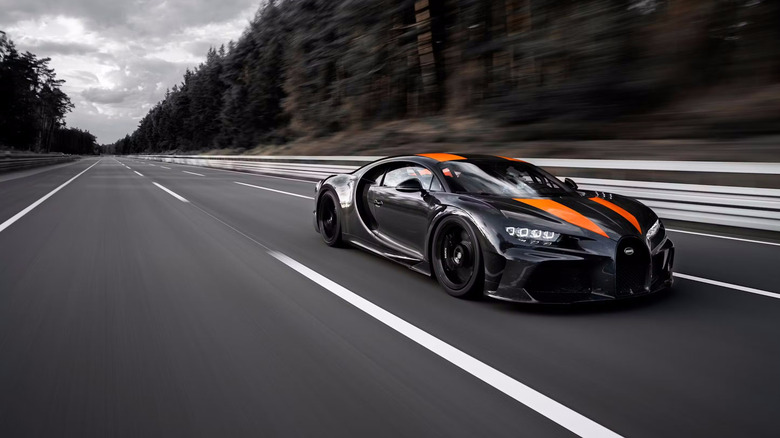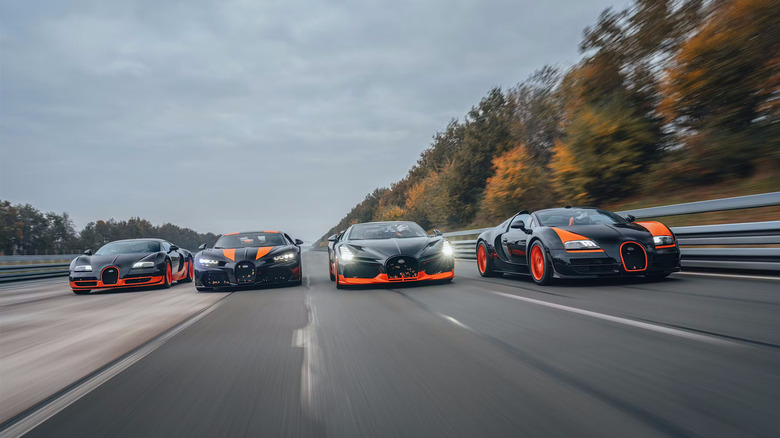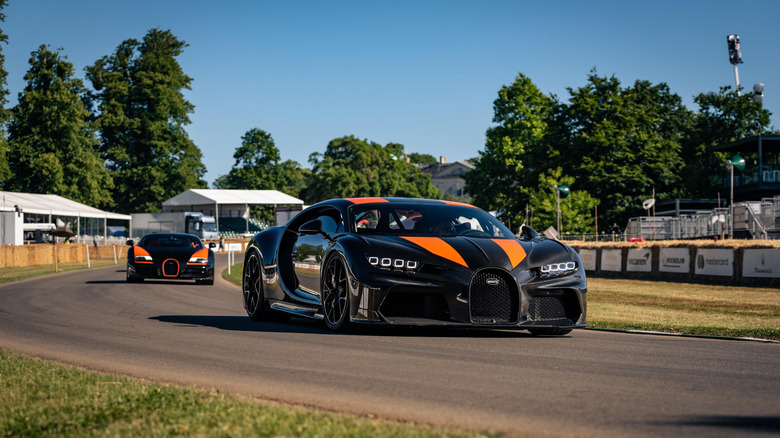The Fastest Car On Record (That's Still Legal On US Roads)
Land speed records are hardly a new phenomenon; the first such mark of 39.34 miles per hour was set by Frenchman Gaston de Chasseloup-Laubat in an electric Jeantaud Duc carriage way back in 1898. That mark can now be surpassed by a strong bicyclist, and modern speed records reflect advances in automotive technology over the intervening decades. In 2019, one European manufacturer staked its claim to the title of fastest production car by reaching a speed that would have seemed impossible to early automakers and motorists. In August of that year, a Bugatti Chiron Super Sport 300+ piloted by test driver Andy Wallace zoomed into the record books when it maxed out at an astonishing 304.77 mph. This not only set a new production car record; it was also the first time a publicly available model had broken the 300 mph barrier.
By way of comparison, a Boeing 747 airliner takes off at around 184 mph, and the fastest Formula 1 race cars max out at a little over 230 mph. Bugatti's record run was made possible by the use of clever aerodynamics, specially-built Michelin tires, and a monstrous 8-liter quad-turbo W16 engine that cranks out over 1,570 hp. Also impressive is how Bugatti managed to navigate the complex landscape of safety standards, aesthetics, and emissions laws. The France-based carmaker was able to create a stunning hypercar that's fully street legal and features luxurious interior appointments like high-grade leather and polished aluminum trim.
Although the record was set in a prototype model, Bugatti made 30 copies of the production-spec Chiron Super Sport 300+ with an elevated ride height and speed limiter. So even if you have $4 million-plus to spare and can get one of the ultra-rare existing examples, you might not be able to quite reach Wallace's speed.
Bugatti has a history of setting speed records
The Chiron Super Sport 300+ is not without its challengers, though. Koenigsegg claims its Jesko Absolut is capable of going 330 mph or more, but hasn't found a suitable test track to make that happen. There's also the Hennessey Venom F5, an American-made hypercar that hit 271.6 mph in testing in 2022. Shelby Super Car (SSC) said its Tuatara had made a 331-mph run in 2020, but retracted the claim a year later. The 1,750-hp Tuatara did establish a certified production car record of 282.9 mph in 2021; that'simpressive, but still well short of 300 mph. SSC has announced its desire to pursue the 300 mph mark, but for now the Bugatti Chiron Super Sport 300+ reigns as the undisputed speed king of U.S. roadways. The simultaneous pursuit of speed and luxury has always been central to the development of Bugatti models, and the 304 mph run by the Chiron Super Sport 300+ is just one of a handful of records set by Bugatti.
In April 2005, Bugatti's Veyron 16.4 became the first production car to go north of 400 kph (249 mph) with a 408.47 km/h (253.81 mph) speed run at Volkswagen's Ehra-Lessien test track. Five years later, the Veyron Super Sport burned up that same asphalt, averaging a top speed of 267.85 mph (431.07 km/h) over two runs in opposite directions. The Veyron's open-top sibling, the Grand Sport Vitesse, also once held its own spot in the speed record book as the world's fastest production roadster, hitting a verified 254.04 mph (408.84 km/h) in 2010.
What are Bugatti's future plans?
The Bugatti Mistral — the last of the models powered by Bugatti's legendary W16 engine — became the wind-in-your-hair speed king in November 2024 at 282 mph (over 450 km/h). There are plenty more speed benchmarks to be set, but the sample highlighted here underscores Bugatti's commitment to making cars that go incredibly fast.
After Bugatti officially broke the 300 mph barrier in 2019, company president Stephan Winkelmann revealed a shift in the company's priorities via a press release. "Our goal was to be the first manufacturer ever to reach the magic 300-mile-per-hour mark," it read. "We have proven several times that we build the fastest cars in the world. In the future, we will focus on other areas."
That position has since changed following the 2021 merger between Bugatti and Rimac Automobili. In 2024, Bugatti Rimac Chief Technology Officer Emilo Scervo outlined the company's updated priorities in a chat with The Drive. "Bugatti in the future for me is going to be high speed but not at heavy cost," he said. "It has to [have] better aerodynamics, with a lighter car, with the more emotional engine ... It is not like a scary high speed drive, but it's getting more emotional and more sophisticated in the way it delivers it."
Rimac CEO Mate Rimac (who also oversees the Bugatti Rimac joint effort) told Top Gear in 2024 that his engineers were working with vendors like Michelin to explore the possibility of going faster than 500 km/h (310.7 mph), and Bugatti's new Turbillion has a 1,000-hp V16 internal combustion engine and three electric motors that boost its total output by another 800 horses. With that much power on hand, more production car speed records certainly seem within reach for Bugatti.


